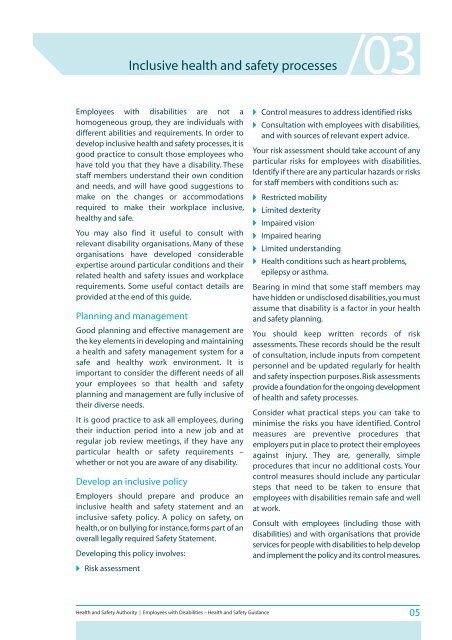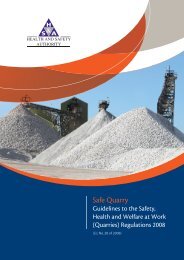Employees with Disabilities - Health and Safety Authority
Employees with Disabilities - Health and Safety Authority
Employees with Disabilities - Health and Safety Authority
Create successful ePaper yourself
Turn your PDF publications into a flip-book with our unique Google optimized e-Paper software.
Inclusive health <strong>and</strong> safety processes /03<br />
<strong>Employees</strong> <strong>with</strong> disabilities are not a<br />
homogeneous group, they are individuals <strong>with</strong><br />
different abilities <strong>and</strong> requirements. In order to<br />
develop inclusive health <strong>and</strong> safety processes,it is<br />
good practice to consult those employees who<br />
have told you that they have a disability. These<br />
staff members underst<strong>and</strong> their own condition<br />
<strong>and</strong> needs, <strong>and</strong> will have good suggestions to<br />
make on the changes or accommodations<br />
required to make their workplace inclusive,<br />
healthy <strong>and</strong> safe.<br />
You may also find it useful to consult <strong>with</strong><br />
relevant disability organisations. Many of these<br />
organisations have developed considerable<br />
expertise around particular conditions <strong>and</strong> their<br />
related health <strong>and</strong> safety issues <strong>and</strong> workplace<br />
requirements. Some useful contact details are<br />
provided at the end of this guide.<br />
Planning <strong>and</strong> management<br />
Good planning <strong>and</strong> effective management are<br />
the key elements in developing <strong>and</strong> maintaining<br />
a health <strong>and</strong> safety management system for a<br />
safe <strong>and</strong> healthy work environment. It is<br />
important to consider the different needs of all<br />
your employees so that health <strong>and</strong> safety<br />
planning <strong>and</strong> management are fully inclusive of<br />
their diverse needs.<br />
It is good practice to ask all employees, during<br />
their induction period into a new job <strong>and</strong> at<br />
regular job review meetings, if they have any<br />
particular health or safety requirements –<br />
whether or not you are aware of any disability.<br />
Develop an inclusive policy<br />
Employers should prepare <strong>and</strong> produce an<br />
inclusive health <strong>and</strong> safety statement <strong>and</strong> an<br />
inclusive safety policy. A policy on safety, on<br />
health,or on bullying for instance,forms part of an<br />
overall legally required <strong>Safety</strong> Statement.<br />
Developing this policy involves:<br />
<br />
Risk assessment<br />
Control measures to address identified risks<br />
Consultation <strong>with</strong> employees <strong>with</strong> disabilities,<br />
<strong>and</strong> <strong>with</strong> sources of relevant expert advice.<br />
Your risk assessment should take account of any<br />
particular risks for employees <strong>with</strong> disabilities.<br />
Identify if there are any particular hazards or risks<br />
for staff members <strong>with</strong> conditions such as:<br />
Restricted mobility<br />
Limited dexterity<br />
Impaired vision<br />
Impaired hearing<br />
Limited underst<strong>and</strong>ing<br />
<strong>Health</strong> conditions such as heart problems,<br />
epilepsy or asthma.<br />
Bearing in mind that some staff members may<br />
have hidden or undisclosed disabilities, you must<br />
assume that disability is a factor in your health<br />
<strong>and</strong> safety planning.<br />
You should keep written records of risk<br />
assessments. These records should be the result<br />
of consultation, include inputs from competent<br />
personnel <strong>and</strong> be updated regularly for health<br />
<strong>and</strong> safety inspection purposes.Risk assessments<br />
provide a foundation for the ongoing development<br />
of health <strong>and</strong> safety processes.<br />
Consider what practical steps you can take to<br />
minimise the risks you have identified. Control<br />
measures are preventive procedures that<br />
employers put in place to protect their employees<br />
against injury. They are, generally, simple<br />
procedures that incur no additional costs. Your<br />
control measures should include any particular<br />
steps that need to be taken to ensure that<br />
employees <strong>with</strong> disabilities remain safe <strong>and</strong> well<br />
at work.<br />
Consult <strong>with</strong> employees (including those <strong>with</strong><br />
disabilities) <strong>and</strong> <strong>with</strong> organisations that provide<br />
services for people <strong>with</strong> disabilities to help develop<br />
<strong>and</strong> implement the policy <strong>and</strong> its control measures.<br />
<strong>Health</strong> <strong>and</strong> <strong>Safety</strong> <strong>Authority</strong> | <strong>Employees</strong> <strong>with</strong> <strong>Disabilities</strong> – <strong>Health</strong> <strong>and</strong> <strong>Safety</strong> Guidance 05

















